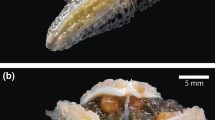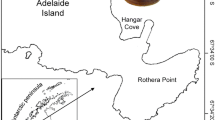Abstract
Two species of small gastropods (<6 mm in length), Amphissa acutecostata (Philippi, 1844) and Gymnobela subaraneosa (Dautzenberg and Fischer, 1896), widely distributed in the northeast Atlantic, were found in large numbers in the Porcupine Seabight (Northeast Atlantic). Except for some aspects of taxonomy and distribution, as well as some data on larval development, the biology of these species is unknown. This study describes basic aspects of the life-history strategies of both species. Histological studies showed that oocyte and sperm development in both species was similar to the gametogenetic patterns observed in other deep-sea gastropods. In females, oogonia proliferated in the germinal epithelium and developed into previtellogenic oocytes (30–40 μm), which grew into vitellogenic primary oocytes. Vitellogenic oocytes were covered by a thin layer of follicle cells involved in the vitellogenic processes. The maximum size for mature oocytes was 99.06 μm for A. acutecostata and 114.82 μm for G. subaraneosa. In A. acutecostata most of the volume of the ovary was occupied by previtellogenic and early vitellogenic oocytes, whereas in G. subaraneosa most of the volume was filled by large vitellogenic oocytes. Both species showed quasi-continuous production of oocytes. The oocyte size-frequency diagrams suggested a continuous release of a small number of oocytes throughout the year for A. acutecostata, and asynchronous periodic spawning events for G. subaraneosa. Gonad development and gametogenesis could be strongly affected by presence of parasites in one of the populations of G. subaraneosa.





Similar content being viewed by others
References
Barber BJ (1996) Gametogenesis of eastern oysters, Crassostrea virginica (Gmelin, 1791), and Pacific oysters, Crassostrea gigas (Thunberg, 1793) in disease-endemic lower Chesapeake Bay. J Shellfish Res 15:285–290
Barnes H, Barnes M (1976) The rate of development of the embryos of Balanus balanoides (L.) from a number of European and American populations and the designation of local races. J Exp Mar Biol Ecol 24:251–269
Bollache L, Rigaud T, Cezilly F (2002) Effects of two acanthocephalan parasites on the fecundity and pairing status of female Gammarus pulex (Crustacea: Amphipoda). J Invertebr Pathol 79:102–110
Bouchet P (1977) Mise en evidence de stades larvaires planctoniques chez des Gastéropodes Prosobranches des étages bathyal et abyssal. Bull Mus Natl Hist Nat 400:947–972
Bouchet P, Fontes, JC (1981) Migrations verticales des larves de gastéropodes abyssaux: arguments nouveaux à l’analyse isotopique de la coquille larvaire et postlarvaire. CR Seances Acad Sci Paris 292:1005–1008
Bouchet P, Warén A (1979) Planktotrophic larval development in deep-water gastropods. Sarsia 64:37–40
Bouchet P, Warén A (1980) Revision of the Northeast Atlantic bathyal and abyssal Neogastropoda excluding Turridae (Mollusca, Gastropoda). Boll Mal 1:123–294
Bouchet P, Warén A (1985) Revision of the Northeast Atlantic bathyal and abyssal Turridae (Mollusca, Gastropoda). J Moll Stud 8:1–119
Bouchet P, Warén A (1994) Ontogenetic migration and dispersal of deep-sea gastropod larvae. In: Young CM, Eckelbarger KJ (eds) Reproduction, larval biology, and recruitment of the deep-sea benthos. Columbia University Press, New York, pp 98–118
Colman JG (1987) Studies of the life history biology of deep-sea gastropod molluscs. PhD thesis, University of Wales
Colman JG, Tyler PA, Gage JD (1986) Larval development of deep-sea gastropods (Prosobranchia: Neogastropoda) from the Rockall Trough. J Mar Biol Assoc UK 66:951–965
Eckelbarger KJ (1983) Evolutionary radiation in polychaete ovaries and vitellogenic mechanisms: their possible role in life history patterns. Can J Zool 61:487–504
Eckelbarger KJ (1994) Diversity of metazoan ovaries and vitellogenic mechanisms: implications for life history theory. Proc Biol Soc Wash 107:193–218
Eckelbarger KJ, Watling L (1995) Role of phylogenetic constraints in determining reproductive patterns in deep-sea invertebrates. Invertebr Biol 114:256–269
Eckelbarger KJ, Young CM (1999) Ultrastructure of gametogenesis in a chemosynthetic mytilid bivalve (Bathymodiolus childressi) from a bathyal, methane seep environment (northern Gulf of Mexico). Mar Biol 135:635–646
Eckelbarger KJ, Young CM, Ramirez-Llodra E, Brooke S, Tyler P (2001) Gametogenesis, spawning behavior, and early development in the “iceworm” Hesiocaeca methanicola (Polychaeta: Hesionidae) from methane hydrates in the Gulf of Mexico. Mar Biol 138:761–775
Fretter V, Graham A (1994) British prosobranch molluscs: their functional anatomy and ecology. The Ray Society, Dorset Press, Dorset
Gage JD, Tyler PA (1982) Growth and reproduction of the deep-sea brittle star Ophiomusium lymani Wyville Thomson. Oceanol Act 5:73–83
Gage JD, Tyler PA (1991) Deep-sea biology: a natural history of organisms at the deep-sea floor. Cambridge University Press, Cambridge
Giangrande A (1997) Polychaete reproductive patterns, life cycles and life histories: an overview. Oceanogr Mar Biol Annu Rev 35:323–386
Gorbushin AM, Levakin IA (1999) The effect of trematode parthenitae on the growth of Onoba aculeus, Littorina saxatilis and L. obtusata (Gastropoda: Prosobranchia). J Mar Biol Assoc UK 79:273–279
Grassle JF (1989) Species diversity in deep-sea communities. Trends Ecol Evol 4:12–15
Grassle JF, Maciolek NJ (1992) Deep-sea biology: a natural history of organisms at the deep-sea floor. Cambridge University Press, Cambridge
Harrison K (1988) Seasonal reproduction in deep-sea Crustacea (Isopoda: Asellota). J Nat Hist 22:175–197
Healy JM, Rowe FWE, Anderson DT (1988) Spermatozoa and spermiogenesis in Xyloplax (class Concentricycloidea): a new type of spermatozoon in the Echinodermata. Zool Scr 17:297–310
Heller J (1993) Hermaphroditism in molluscs. Biol J Linn Soc 48:19–42
Hessler RR Sanders HL (1967) Faunal diversity in the deep sea. Deep-Sea Res 14:65–78
Jaeckle WB (1995) Variation in the size, energy content and biochemical composition of invertebrate eggs: correlates to the mode of larval development. In: McEdward L (ed) Ecology of marine invertebrate larvae. CRC, Florida, pp 49–78
Levin L, Plaia GR, Huggett CL (1994) The influence of natural organic enhancement on life histories and community structure of bathyal polychaetes. In: Young CM, Eckelbarger KJ (eds) Reproduction, larval biology, and recruitment of the deep-sea benthos. Columbia University Press, New York, pp 261–283
Lightfoot RH, Tyler PA, Gage JD (1979) Seasonal reproduction in deep-sea bivalves and brittlestars. Deep-Sea Res 26:967–973
Niehoff B (2003) Gonad morphology and oocyte development in Pseudocalanus spp. in relation to spawning activity. Mar Biol 143:759–768. DOI 10.1007/s00227-003-1034-7
Ramirez-Llodra E (2002) Fecundity and life-history strategies in marine invertebrates. Adv Mar Biol 43:88–170
Ramirez-Llodra E, Tyler PA, Copley JTP (2000) Reproductive biology of three caridean shrimp, Rimicaris exoculata, Chocaris chacei and Mirocaris fortunata (Caridea: Decapoda), from hydrothermal vents. J Mar Biol Assoc UK 80:473–484
Ramirez-Llodra E, Tyler PA, Billett DSM (2002) Reproductive biology of porcellanasterid asteroids from three abyssal sites in the northeast Atlantic with contrasting food input. Mar Biol 140:773–788
Rex MA, Warén A (1982) Planktotrophic development in deep-sea prosobranch snails from the western North Atlantic. Deep-Sea Res 29:171–184
Rex MA, Van Ummersen CA, Turner RD (1979) Reproductive pattern in the abyssal snail Benthonella tenella (Jeffreys). In: Stancyk SE (ed) Reproductive ecology of marine invertebrates. University of South Carolina Press, pp 173–188
Rex MA, Stuart CT, Hessler RR, Allen JA, Sanders HL, Wilson GDF (1993) Global-scale latitudinal patterns of species diversity in the deep-sea benthos. Nature 365:636–639
Rex MA, Stuart CT, Coyne G (2000) Latitudinal gradients of species richness in the deep-sea benthos of the North Atlantic. Proc Natl Acad Sci USA 97:4082–4085
Rice AL, Aldred RG, Darlington E, Wild RA (1982) The quantitative estimation of the deep-sea megabenthos: a new approach to an old problem. Oceanol Acta 5:63–72
Rice AL, Billett DSM, Thurston MH, Lampitt RS (1991) The Institute of Oceanographic Sciences biology programme in the Porcupine Seabight: background and general introduction. J Mar Biol Assoc UK 71:281–310
Rokop F (1979) Year-round reproduction in the deep-sea bivalve molluscs. In: Stancyk SE (ed) Reproductive ecology of marine invertebrates. University of South Carolina Press, pp 189–198
Sato S (1999) Genetic and environmental control of growth and reproduction of Phacosoma japonicum (Bivalvia: Veneridae). Veliger 42:54–61
Scheltema RS (1972) Reproduction and dispersal of bottom dwelling deep-sea invertebrates: a speculative summary. In: Brauer RW (ed) Barobiology and the experimental biology of the deep sea. University of North Carolina Press, pp 58–68
Scheltema RS (1994) Adaptations for reproduction among deep-sea benthic molluscs: an appraisal of the existing evidence. In: Young CM, Eckelbarger KJ (eds) Reproduction, larval biology, and recruitment of the deep-sea benthos. Columbia University Press, New York, pp 44–75
Sokal RR, Rohlf J (1995) Biometry, 3rd edn. Freeman, New York
Tetreault F, Himmelman JH, Measures L (2000) Impact of a castrating trematode, Neophasis sp. on the common whelk, Buccinum undatum, in the Northern Gulf of St. Lawrence. Biol Bull Mar Biol Lab Woods Hole 2:261–271
Tyler PA, Gage JD (1984) Seasonal reproduction of Echinus affinis (Echinodermata: Echinoidea) in the Rockall Trough, northeast Atlantic Ocean. Deep-Sea Res 31:387–402
Tyler CR, Sumpter JP (1996) Oocyte growth and development in teleosts. Rev Fish Biol Fish 6:287–318
Tyler PA, Pain SL, Gage JD (1982) The reproductive biology of the deep-sea asteroid Bathybiaster vexillifer. J Mar Biol Assoc UK 62:57–69
Tyler PA, Harvey R, Giles LA, Gage JD (1992) Reproductive strategies and diet in deep-sea nuculanid protobranchs (Bivalvia: Nuculoidea) from the Rockall Trough. Mar Biol 114:571–580
Young CM (2003) Reproduction, development and life-history traits. In: Tyler PA (ed) Ecosystems of the deep oceans. Elsevier, Amsterdam, pp 381–426
Acknowledgements
We would like to thank the officers and crews of RSS Challenger and RSS Discovery, as well as the colleagues who have been instrumental in collecting the samples used in this study. This research has been supported by a Postdoctoral Marie Curie Fellowship of the European Community programme “Energy, Environment and Sustainable Development” under contract EVK2-CT-2001-50010 to Celia Olabarria. We would also like to thank Prof. P.A. Tyler for valuable comments on the first draft of this manuscript and Dr. P. Bouchet for checking voucher material of G. subaraneosa. This material has been deposited in the Muséum National d’Histoire Naturelle, Paris.
Author information
Authors and Affiliations
Corresponding author
Additional information
Communicated by J.P. Thorpe, Port Erin
Rights and permissions
About this article
Cite this article
Olabarria, C., Ramirez-Llodra, E. Reproductive strategies of two deep-sea gastropod species from the Porcupine Seabight (Northeast Atlantic). Marine Biology 145, 541–549 (2004). https://doi.org/10.1007/s00227-004-1333-7
Received:
Accepted:
Published:
Issue Date:
DOI: https://doi.org/10.1007/s00227-004-1333-7




